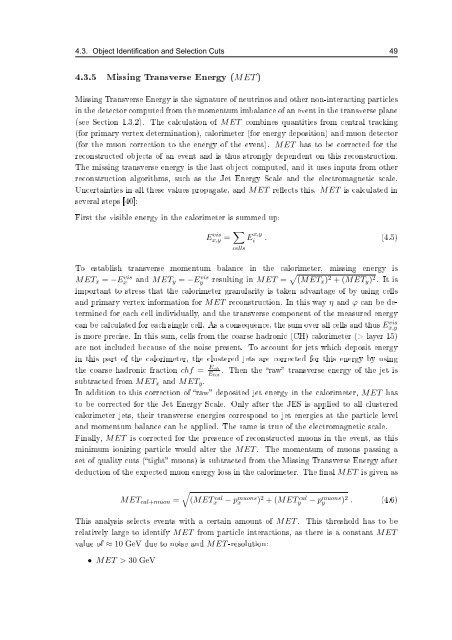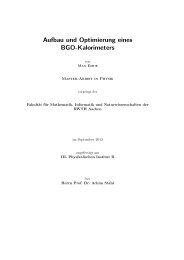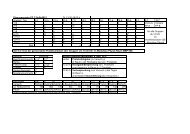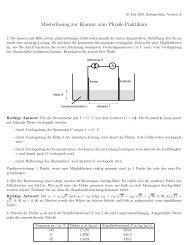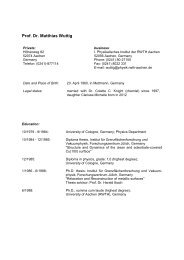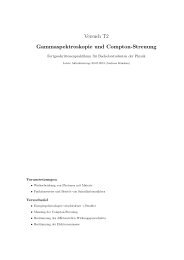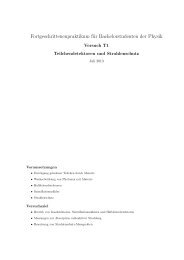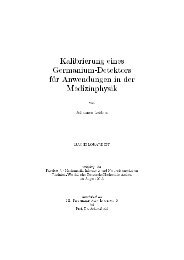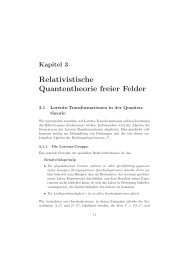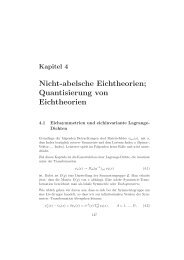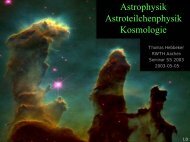Model Independent Search for Deviations from the Standard Model ...
Model Independent Search for Deviations from the Standard Model ...
Model Independent Search for Deviations from the Standard Model ...
Create successful ePaper yourself
Turn your PDF publications into a flip-book with our unique Google optimized e-Paper software.
4.3. Object Identification and Selection Cuts 49<br />
4.3.5 Missing Transverse Energy (MET)<br />
Missing Transverse Energy is <strong>the</strong> signature of neutrinos and o<strong>the</strong>r non-interacting particles<br />
in<strong>the</strong>detectorcomputed<strong>from</strong><strong>the</strong>momentumimbalanceofaneventin<strong>the</strong>transverseplane<br />
(see Section 1.3.2). The calculation of MET combines quantities <strong>from</strong> central tracking<br />
(<strong>for</strong> primary vertex determination), calorimeter (<strong>for</strong> energy deposition) and muon detector<br />
(<strong>for</strong> <strong>the</strong> muon correction to <strong>the</strong> energy of <strong>the</strong> event). MET has to be corrected <strong>for</strong> <strong>the</strong><br />
reconstructed objects of an event and is thus strongly dependent on this reconstruction.<br />
The missing transverse energy is <strong>the</strong> last object computed, and it uses inputs <strong>from</strong> o<strong>the</strong>r<br />
reconstruction algorithms, such as <strong>the</strong> Jet Energy Scale and <strong>the</strong> electromagnetic scale.<br />
Uncertainties in all <strong>the</strong>se values propagate, and MET reects this. MET is calculated in<br />
several steps [40]:<br />
First <strong>the</strong> visible energy in <strong>the</strong> calorimeter is summed up:<br />
Ex,y vis = ∑ E x,y<br />
i<br />
. (4.5)<br />
cells<br />
To establish transverse momentum balance in <strong>the</strong> calorimeter, missing energy is<br />
MET x = −Ex<br />
and vis MET y = −Ey<br />
resulting in vis<br />
MET = √ (MET x ) 2 + (MET y ) . It is<br />
important to stress that <strong>the</strong> calorimeter granularity is taken advantage of by using 2 cells<br />
and primary vertex in<strong>for</strong>mation <strong>for</strong> MET reconstruction. In this way η and ϕ can be determined<br />
<strong>for</strong> each cell individually, and <strong>the</strong> transverse component of <strong>the</strong> measured energy<br />
canbecalculated<strong>for</strong>eachsinglecell. Asaconsequence, <strong>the</strong>sumoverallcellsandthus Ex,y<br />
is more precise. In this sum, cells <strong>from</strong> <strong>the</strong> coarse hadronic (CH) calorimeter (> layer 15)<br />
vis<br />
are not included because of <strong>the</strong> noise present. To account <strong>for</strong> jets which deposit energy<br />
in this part of <strong>the</strong> calorimeter, <strong>the</strong> clustered jets are corrected <strong>for</strong> this energy by using<br />
<strong>the</strong> coarse hadronic fraction chf = E ch<br />
E tot<br />
. Then <strong>the</strong> raw transverse energy of <strong>the</strong> jet is<br />
subtracted <strong>from</strong> MET x and MET y .<br />
In addition to this correction of raw deposited jet energy in <strong>the</strong> calorimeter, MET has<br />
to be corrected <strong>for</strong> <strong>the</strong> Jet Energy Scale. Only after <strong>the</strong> JES is applied to all clustered<br />
calorimeter jets, <strong>the</strong>ir transverse energies correspond to jet energies at <strong>the</strong> particle level<br />
and momentum balance can be applied. The same is true of <strong>the</strong> electromagnetic scale.<br />
Finally, MET is corrected <strong>for</strong> <strong>the</strong> presence of reconstructed muons in <strong>the</strong> event, as this<br />
minimum ionizing particle would alter <strong>the</strong> MET. The momentum of muons passing a<br />
set of quality cuts (tight muons) is subtracted <strong>from</strong> <strong>the</strong> Missing Transverse Energy after<br />
deduction of <strong>the</strong> expected muon energy loss in <strong>the</strong> calorimeter. The nal MET is given as<br />
MET cal+muon =<br />
√<br />
(MET cal x<br />
− p muons x ) 2 + (METy<br />
cal − p muons y ) 2 . (4.6)<br />
This analysis selects events with a certain amount of MET. This threshold has to be<br />
relatively large to identify MET <strong>from</strong> particle interactions, as <strong>the</strong>re is a constant MET<br />
value of ≈ 10 GeV due to noise and MET-resolution:<br />
• MET > 30 GeV


